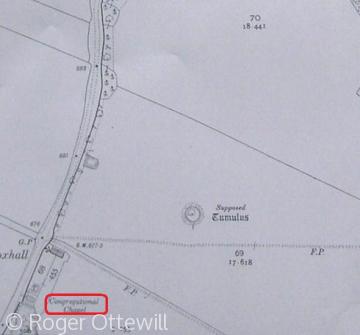Farleigh Congregational Chapel

This chapel served the parish of Farleigh Wallop where the Congregational cause was established in 1900. Initially, services took the form of cottage meetings. In the course of time, however, ‘as members increased, the services were conducted at … [a] farm, by kind permission of Mr Cole.’ Then in 1906 a purpose built chapel was constructed. It was opened with considerable fanfare on Thursday 6th September by Miss Sarah Jane Wallis the Mayoress of Basingstoke, who had donated half of the cost. The chapel was located at Foxhall some distance from the main settlement on a site owned by the Earl of Portsmouth who ‘offered it on a 999 years’ lease at a nominal rent.’ The simple building was ‘of corrugated iron, with a patent felt roof, for which … [was] claimed the advantage of keeping … [it] cool in hot weather. At the rear end … [was] a shed for cycles etc., … [for] preachers and visitors from distant churches. The interior … [was] matchboarded, and … [it could] accommodate nearly one hundred people.’ In her remarks the Mayoress commented that it was now ‘comparatively easy … for those who live in villages as well as in towns to hear the Gospel of the grace of God.’ At a public meeting held later in the day, Alfred Capes Tarbolton, the minister of the parent church - London Street in Basingstoke, observed that although ‘it was only a small building, … it was well sometimes to compare the small with the great. He had thought of Solomon’s temple as compared with their little chapel. Although there were no glittering jewels or outward adornments, yet the spiritual life and glory of their services might exceed that of Solomon’s temple.’
During the first few years after it was opened, services were held every Sunday evening and in the afternoon there was a Sunday school. There was also a fortnightly Mother’s Meeting. After a promising start, however, it was not long before the cause was struggling. Like many rural chapels the removal of families who had played a crucial role in its activities created difficulties and resulted in the closure of the Sunday school. Thus, by 1914 Farleigh was already being described as a ‘weak cause’. The chapel was ‘temporarily closed’ from 1918 to 1920. It reopened in 1921 and hosted well-attended harvest thanksgiving services during the first half of the 1920s. The roof was repaired and a stove installed. However, in 1927 the London Street deacons decided to abandon the work at Farleigh and the chapel was closed permanently, just over 20 years after it had been opened. It is not clear what happened to the building, but today there is little evidence that a chapel ever existed on the site which is covered with trees.
[All quotations are from the Hants and Berks Gazette, September 8, 1906.]
Roger Ottewill
October 2013
Content derived from research undertaken as part of the Victoria County History project




